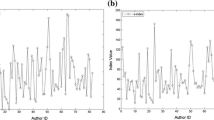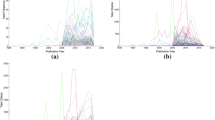Abstract
In the field of scientific assessment of scholars, there were several metrics has been given by the scholars. From the list of indices, the h-index is widely accepted for the scientific evaluation of scholars. However, the h-index has several limitations, especially in the case of consideration of excess citation count. In this context, the e-index and EM-index have been proposed. The e-index only considers the excess citation count, while the EM-index considers both core and excess citation count. “The EM-index is the square root of the sum of the EM-index component”. In this index, every component has equal importance. But how can we consider every component equally? The first element and the 100th elements can not be identical. This article discussed the iterative weighted EM-index to address this issue. To consider the impact of all cited atricles, the multidimensional h-index and the \(EM^{\prime}\)-index were proposed. The multidimensional h-index has not considered the excess citation count and also not come up with any global index value. The \(EM^{\prime}\)-index overcomes this issue, but this index follows the same pattern as the EM-index suffers. Further to accomplish the above-discussed issue, the iterative weighted \(EM^{\prime}\)-index also discussed in this article. An empirical study has been performed on 82 scholars’ publications and citation data. From the empirical research, we concluded that this could be an effective solution in the scientific assessment of scholars.








Similar content being viewed by others
References
Alonso, S., Cabrerizo, F. J., Herrera-Viedma, E., & Herrera, F. (2009). h-index: A review focused in its variants, computation and standardization for different scientific fields. Journal of Informetrics, 3(4), 273–289.
Anderson, T. R., Hankin, R. K., & Killworth, P. D. (2008). Beyond the durfee square: Enhancing the h-index to score total publication output. Scientometrics, 76(3), 577–588.
Bihari, A., & Tripathi, S. (2017). Em-index: A new measure to evaluate the scientific impact of scientists. Scientometrics, 112(1), 659–677.
Bornmann, L., & Daniel, H.-D. (2007a). Convergent validation of peer review decisions using the h index: Extent of and reasons for type i and type ii errors. Journal of Informetrics, 1(3), 204–213.
Bornmann, L., & Daniel, H.-D. (2007b). What do we know about the h index? Journal of the American Society for Information Science and Technology, 58(9), 1381–1385.
Costas, R., & Bordons, M. (2007). The h-index: Advantages, limitations and its relation with other bibliometric indicators at the micro level. Journal of Informetrics, 1(3), 193–203.
Dorta-González, P., & Dorta-González, M.-I. (2011). Central indexes to the citation distribution: A complement to the h-index. Scientometrics, 88(3), 729–745.
Egghe, L. (2006a). An improvement of the h-index: The g-index. ISSI Newsletter, 2(1), 8–9.
Egghe, L. (2006b). Theory and practise of the g-index. Scientometrics, 69(1), 131–152.
Egghe, L. (2007). Dynamic h-index: The hirsch index in function of time. Journal of the American Society for Information Science and Technology, 58(3), 452–454.
García-Pérez, M. (2009). A multidimensional extension to hirsch’s h-index. h-index. Scientometrics, 81(3), 779–785.
García-Pérez, M. A. (2012). An extension of the h index that covers the tail and the top of the citation curve and allows ranking researchers with similar h. Journal of Informetrics, 6(4), 689–699.
Hirsch, J. E. (2005). An index to quantify an individual’s scientific research output. Proceedings of the National Academy of Sciences of the United States of America, 16569–16572.
Jin, B. (2006). H-index: An evaluation indicator proposed by scientist. Science Focus, 1(1), 8–9.
Jin, B. (2007). The ar-index: Complementing the h-index. ISSI Newsletter, 3(1), 6.
Jin, B., Liang, L., Rousseau, R., & Egghe, L. (2007). The r-and ar-indices: Complementing the h-index. Chinese Science Bulletin, 52(6), 855–863.
Maabreh, M., & Alsmadi, I. M. (2012). A survey of impact and citation indices: Limitations and issues. International Journal of Advanced Science and Technology, 40, 35–53.
Martin, B. R. (1996). The use of multiple indicators in the assessment of basic research. Scientometrics, 36(3), 343–362.
Prathap, G. (2010). Is there a place for a mock h-index? Scientometrics, 84(1), 153–165.
Rosenberg, M. S. (2014). A biologist’s? Guide to impact factors. PeerJ PrePrints: Technical report.
Rousseau, R., & Ye, F. Y. (2008). A proposal for a dynamic h-type index. Journal of the American Society for Information Science and Technology, 59(11), 1853–1855.
Schreiber, M. (2008). A modification of the h-index: The h m-index accounts for multi-authored manuscripts. Journal of Informetrics, 2(3), 211–216.
Schubert, A. (2011). A hirsch-type index of co-author partnership ability. Scientometrics, 91(1), 303–308.
Todeschini, R. (2011). The j-index: A new bibliometric index and multivariate comparisons between other common indices. Scientometrics, 87(3), 621–639.
Todeschini, R., & Baccini, A. (2016). Handbook of bibliometric indicators: Quantitative tools for studying and evaluating research. Hoboken: Wiley.
Van Leeuwen, T. N., Visser, M. S., Moed, H. F., Nederhof, T. J., & Van Raan, A. F. (2003). The holy grail of science policy: Exploring and combining bibliometric tools in search of scientific excellence. Scientometrics, 57(2), 257–280.
Vanclay, J. K. (2007). On the robustness of the h-index. Journal of the American Society for Information Science and Technology, 58(10), 1547–1550.
Zhang, C.-T. (2009). The e-index, complementing the h-index for excess citations. PLoS ONE, 4(5), e5429.
Author information
Authors and Affiliations
Corresponding author
Rights and permissions
About this article
Cite this article
Bihari, A., Tripathi, S. & Deepak, A. Iterative weighted EM and iterative weighted EM′-index for scientific assessment of scholars. Scientometrics 126, 5551–5568 (2021). https://doi.org/10.1007/s11192-021-03937-8
Received:
Accepted:
Published:
Issue Date:
DOI: https://doi.org/10.1007/s11192-021-03937-8




